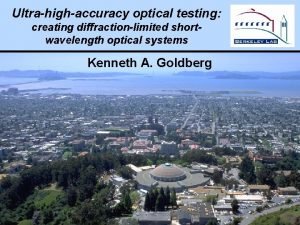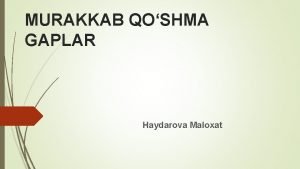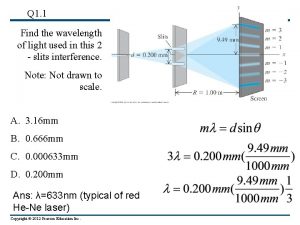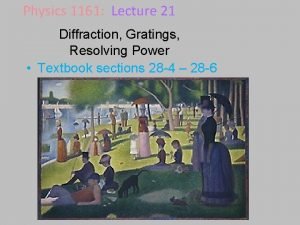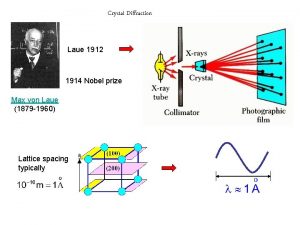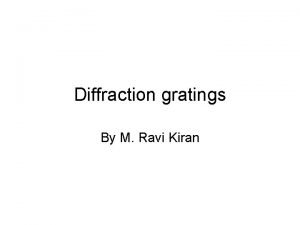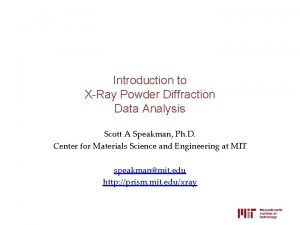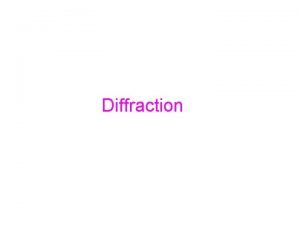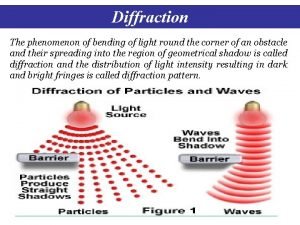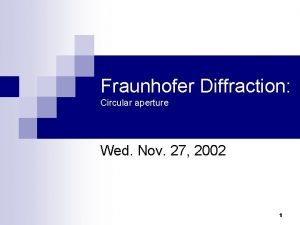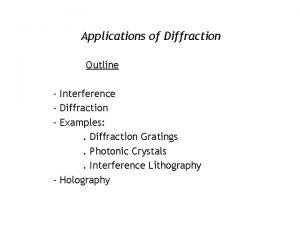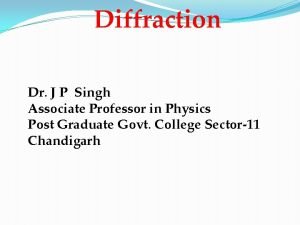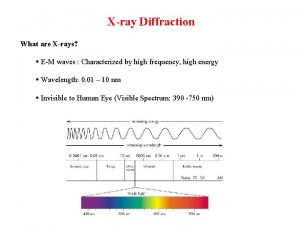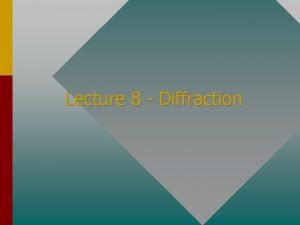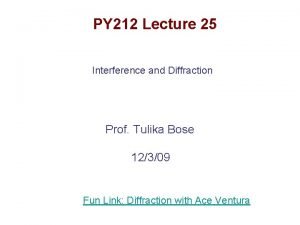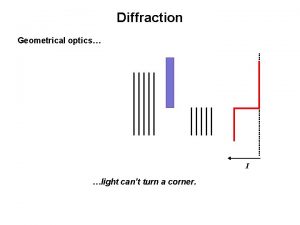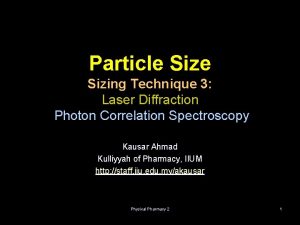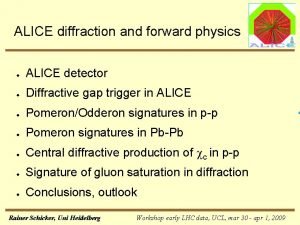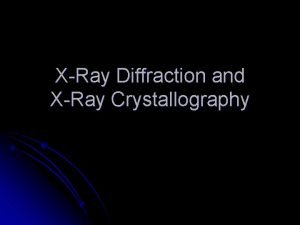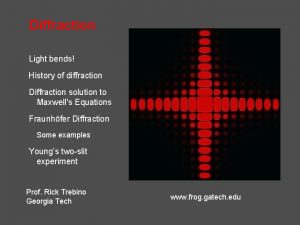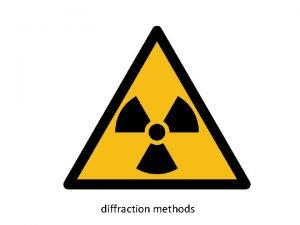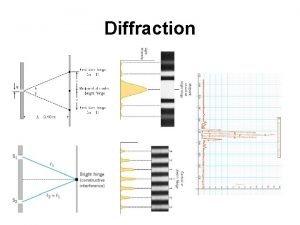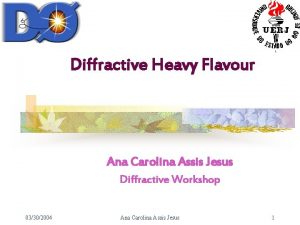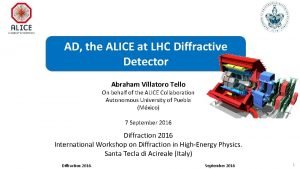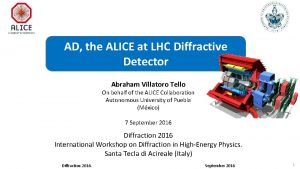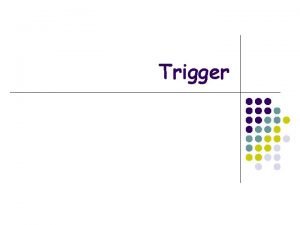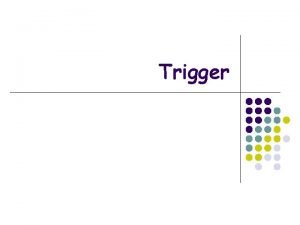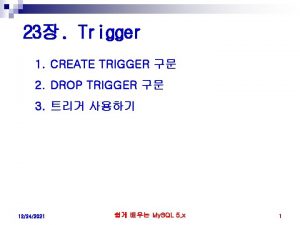Diffraction at ALICE ALICE detector Diffractive gap trigger


















- Slides: 18

Diffraction at ALICE ● ALICE detector ● Diffractive gap trigger in ALICE ● Pomeron signatures in p-p ● Odderon signatures in p-p ● Signature of gluon saturation in diffraction ● Conclusions, outlook Rainer Schicker, Uni Heidelberg EDS 09, jun 29 – july 3, 2009, CERN

The ALICE experiment Acceptance central barrel -0. 9 < h < 0. 9 Acceptance muon spectr. HMPID TRD ITS TPC TOF MUON SPEC. PHOS -2. 5 < h < -4. Rainer Schicker, Uni Heidelberg EDS 09, jun 29 – july 3, 2009, CERN

ALICE diffractive gap trigger → additional forward detectors (no particle identification) 1<h<5 -4 < h < -1 → definition of gaps h+ , h_ p-p luminosity L = 5 x 1030 cm-2 s-1 : → one interaction/ 80 bunches diffractive L 0 trigger (hardware): Pixel or TOF mult (central barrel) gap h : 3 < h < 5 → Dh ~ 0. 5 + gap h-: -2 < h < -4 → Dh ~ 0. 5 high level trigger (software): -3. 7 < h < 5 Rainer Schicker, Uni Heidelberg EDS 09, jun 29 – july 3, 2009, CERN

ALICE central barrel particle identification Particle identification by d. E/dx in central barrel as function of momentum In addition time of flight information for non-relativistic momenta Rainer Schicker, Uni Heidelberg Electron-pion separation in TRD as function of momentum →identify vector mesons by e+e- decay EDS 09, jun 29 – july 3, 2009, CERN

ALICE central barrel comparison to other LHC detectors h-pt acceptance low magnetic field Magn. PT cutoff Material field (T) Ge. V/c x/x 0 (%) ALICE 0. 2 -0. 5 0. 1 -0. 25 7 ATLAS 2. 0 0. 5 (0. 08) 20 CMS 4. 0 0. 75 (0. 2) 30 LHCb 4 Tm 0. 1 3. 2 → low p. T trigger ? →good ALICE acceptance for f, J/Psi, Y by electron decays (p. T > 0 Me. V/c) Rainer Schicker, Uni Heidelberg EDS 09, jun 29 – july 3, 2009, CERN

ALICE forward calorimeter • neutron calorimeter on each side – Placed at 116 m from interaction region – Measures neutral energy at 0 o • Diffractive events with and without proton breakup: – pp → pp. X : no energy in zero degree calorimeters – pp → p. N*X, N*N*X : energy in one or in both calorimeters Identify the three topologies: A B C → what are f(xi), g(xi), h(xi) ? Rainer Schicker, Uni Heidelberg EDS 09, jun 29 – july 3, 2009, CERN

ALICE diffractive physics • ALICE acceptance matched to diffractive central production: g -pomeron, double pomeron, odderon-pomeron central barrel Dh ~ 3 Data taking: pp @ L = 5 x 1030 cm-2 s-1 p. Pb @ L = 1029 cm-2 s-1 Pb. Pb @ L = 1027 cm-2 s 1 Rainer Schicker, Uni Heidelberg Dh ~ 4 f gap had gap h EDS 09, jun 29 – july 3, 2009, CERN

Pomeron signatures POMERON: C = +1 part of gluon color singlet exchange amplitude Compare pomeron-pomeron fusion events to min bias inelastic events 1) Enhanced production cross section of glueball states: study resonances in central region when two rapidity gaps are required 2) Slope pomeron traj. a‘ ~ 0. 25 Ge. V-2 in DL fit, a‘ ~ 0. 1 Ge. V-2 in vector meson production at HERA, t-slope triple pom-vertex < 1 Ge. V-2 → mean kt in pomeron wave function a‘ ~ 1/kt 2 probably kt > 1 Ge. V → <p. T> secondaries in double pomeron > <p. T> secondaries min bias 3) kt > 1 Ge. V implies large effective temperature Rainer Schicker, Uni Heidelberg → K/p, h‘/p ratios enhanced EDS 09, jun 29 – july 3, 2009, CERN

Central exclusive π+π- production at √s = 63 Ge. V Data taken by Axial Field Spectrometer at ISR √s = 63 Ge. V (R 807) very forward drift chambers added for proton detection p π+π- p f 0(600)=σ no ρ f 0(980) 3500 events/25 Me. V T. Akesson et al 1986: Flavour independence: equal numbers of π+π- and K+K- pairs for masses larger than 1 Ge. V Rainer Schicker, Uni Heidelberg M(π+π-) G(1710)? ? Structures not well understood beyond f(980) Not studied at higher √s EDS 09, jun 29 – july 3, 2009, CERN

Signature Odderon cross section ODDERON: C = -1 part of gluon color singlet exchange amplitude Look at exclusive processes with rapidity gaps Examples: diffractive pseudo scalar and tensor meson production: C = +1 states diffractive vector meson production: C = -1 states → measure cross sections Rainer Schicker, Uni Heidelberg EDS 09, jun 29 – july 3, 2009, CERN

The hunt for the Odderon • Production cross sections in pp at LHC energies – diffractive production: → contributions from Photon-Photon, Photon-Odderon, Odderon-Odderon – Look for diffractive J/Y production: → Photon-Pomeron, Odderon-Pomeron contributions → such an experimental effort is a continuation of physics programs carried out at LEP (gg) and HERA (g-Odderon) Rainer Schicker, Uni Heidelberg EDS 09, jun 29 – july 3, 2009, CERN

Diffractive J/Y production in pp at LHC ● ● First estimates by Schäfer, Mankiewicz, Nachtmann 1991 ds Motyka, Szymanowski, Cudell p. QCD estimate by Bzdak, dy y=0 – Photon: t-integrated ds dy y=0 Odderon: t-integrated At L = 5 x 1030 cm-2 s-1: – → s ~ 15 nb (2. 4 - 27 nb) ~ 0. 9 nb (0. 3 - 4 nb) 0. 15 J/Y in ALICE central barrel in 1 s, 150 k in 106 +e- channel in 106 s → 9000 in e → identify Photon and Odderon contribution by analysing p. T distribution ( Odderon harder p. T spectrum ) Rainer Schicker, Uni Heidelberg EDS 09, jun 29 – july 3, 2009, CERN

Signature Odderon interference ● Cross sections contain squared Odderon amplitudes → Odderon-Pomeron interference ! ds ~ Ag(AP + AO) 2 d. Nq ~ AP 2 + 2 Re(APAO*) + AO 2 → look at final states which can be produced by Odderon or Pomeron exchange → find signatures for interference of Codd and C-even amplitude Rainer Schicker, Uni Heidelberg EDS 09, jun 29 – july 3, 2009, CERN

Interference signal • Interference effects (relative contribution ) – Asymmetries in and pairs in continuum → charge asymmetry relative to polar angle of p+ in dipion rest frame → fractional energy asymmetry in open charm diffractive photoproduction → asymmetries in HERA kinematics estimated 10 % - 15 % Rainer Schicker, Uni Heidelberg EDS 09, jun 29 – july 3, 2009, CERN

Gluon saturation • Fits of parton densities xuv, xdv, xg, x. S to HERA data - How does gluon density behave at low x ? - Where does gluon saturation set in ? - Are there observables which are sensitive to gluon saturation ? Rainer Schicker, Uni Heidelberg EDS 09, jun 29 – july 3, 2009, CERN

Heavy quark photoproduction in pp @ LHC • Photoproduction of – photon fluctuates into , Golec-Biernat, – Interacts as color dipole Wuesthoff 1999 σ0, λ from fits of F 2 with x < 0. 01 → σdip saturates when r ~ 2 R 0 ● -production cross section in ppcollisions (LHC) Collinear p. QCD CGC model 16 mb 5 mb 230 nb 110 nb Rainer Schicker, Uni Heidelberg Goncalves, Machado Phys. Rev. D 71 (2005) EDS 09, jun 29 – july 3, 2009, CERN

Diffractive Photoproduction of heavy quarks • Advantage of diffractive photoproduction – Clear final state defined by two rapidity gaps pp p. Pb Pb. Pb 92 nb 54 mb 59 mb Goncalves, Machado 0. 2 nb 0. 09 mb 0. 01 mb Phys. Rev. D 75 (2007) p. Pb mode: L = 1029 cm-2 s-1 g R (cc) ~ 5 Hz Acceptance ~ 10 %, Efficiency ~ 50 % g R(cc)~20 k per day Heavy quarks can also be produced by central exclusive diffraction, ie two pomeron fusion g harder spectrum of quarks, hence could be disentangled in p. T spectrum Rainer Schicker, Uni Heidelberg EDS 09, jun 29 – july 3, 2009, CERN

Conclusions, outlook ● ● ALICE has unique opportunity to do soft diffractive physics @LHC Diffractive trigger defined by two rapidity gaps ● Neutral energy measurement at 00 ● Phenomenology of Pomeron/Odderon ● ● Gluon saturation in heavy-quark photoproduction Photon-Photon physics Rainer Schicker, Uni Heidelberg EDS 09, jun 29 – july 3, 2009, CERN
 Diffractive null test
Diffractive null test Ergash gapli qo shma gaplar misollar
Ergash gapli qo shma gaplar misollar Application domain and execution domain
Application domain and execution domain Diffraction through single slits derivation
Diffraction through single slits derivation Multiple slits diffraction
Multiple slits diffraction Laue diffraction
Laue diffraction Transmission grating
Transmission grating Diffraction peak
Diffraction peak Electromagnetic waves in water
Electromagnetic waves in water Diffraction
Diffraction Fraunhofer diffraction pattern circular aperture
Fraunhofer diffraction pattern circular aperture Diffraction examples
Diffraction examples Path length difference
Path length difference Missing order in diffraction
Missing order in diffraction Diffraction
Diffraction Diffraction
Diffraction Double slit diffraction
Double slit diffraction Fresnel and fraunhofer difference
Fresnel and fraunhofer difference Laser diffraction spectroscopy
Laser diffraction spectroscopy
